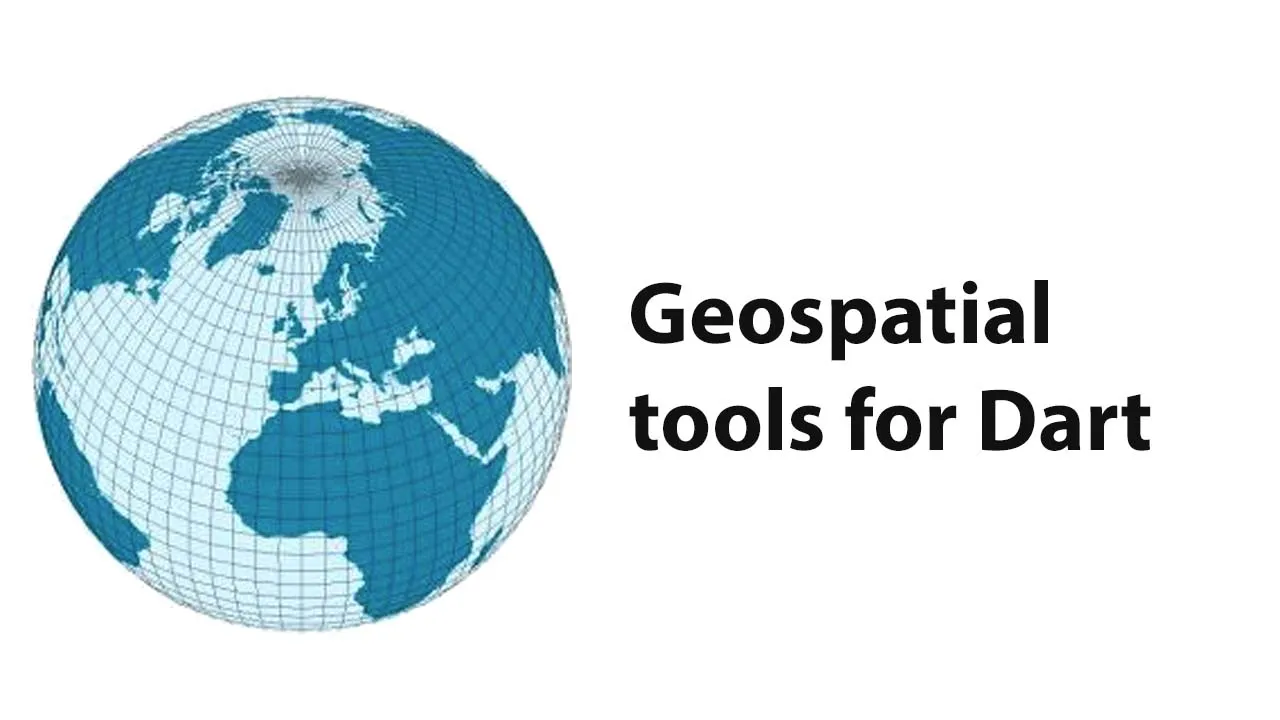Geospatial data structures, tools and utilities for Dart and Flutter mobile developers.
This repository is at BETA stage, interfaces not fully final yet.
The geocore library package, based on Dart code hosted by this repository, provides geospatial data structures (features, geometry and metadata) and utilities to parse GeoJSON and WKT (Well-known text representation of geometry) data. The package also supports representing both geographic (decimal degrees or longitude-latitude) and projected (or cartesian XYZ) coordinates in 2D and 3D.
Some samples from the geocore package, please see the package itself for more documentation:
| Geometry | Shape | Samples to create instances |
|---|---|---|
| Point | Point2(x: 30.0, y: 10.0) Point2.from([30.0, 10.0]) Point2.parse('30 10') | |
| LineString | LineString.parse('30 10, 10 30, 40 40', Point2.geometry) | |
| Polygon | Polygon.parse('(30 10, 40 40, 20 40, 10 20, 30 10)', Point2.geometry) | |
| Polygon (with a hole) | Polygon.parse('(35 10, 45 45, 15 40, 10 20, 35 10), (20 30, 35 35, 30 20, 20 30)', Point2.geometry) |
As another library package, geodata provides a geospatial API client supporting reading GeoJSON and other geospatial data sources from web and file sources.
Please see also generic (non-geospatial) data structures, tools and utilities at the separate Dataflow tools for Dart repository.
Use this package as a library
Depend on it
Run this command:
With Dart:
$ dart pub add geodataWith Flutter:
$ flutter pub add geodataThis will add a line like this to your package's pubspec.yaml (and run an implicit dart pub get):
dependencies:
geodata: ^0.7.0
Alternatively, your editor might support dart pub get or flutter pub get. Check the docs for your editor to learn more.
Import it
Now in your Dart code, you can use:
import 'package:geodata/geodata.dart';// Copyright (c) 2020-2021 Navibyte (https://navibyte.com). All rights reserved.
// Use of this source code is governed by a “BSD-3-Clause”-style license that is
// specified in the LICENSE file.
//
// Docs: https://github.com/navibyte/geospatial
// ignore_for_file: avoid_print
// ignore_for_file: avoid_catches_without_on_clauses
import 'package:equatable/equatable.dart';
import 'package:attributes/values.dart';
import 'package:datatools/fetch_http.dart';
import 'package:geocore/geo.dart';
import 'package:geocore/feature.dart';
import 'package:geodata/geojson_features.dart';
import 'package:geodata/oapi_features.dart';
/*
To test run this from command line:
GeoJSON (file) resource as a data source:
dart example/geodata_example.dart geojson https://earthquake.usgs.gov/earthquakes/feed/v1.0/ summary/2.5_day.geojson 3 items
OGC API Features data sources:
dart example/geodata_example.dart oapif https://demo.pygeoapi.io/master/ lakes 2 items
dart example/geodata_example.dart oapif https://demo.pygeoapi.io/master/ lakes 2 items id 3
dart example/geodata_example.dart oapif https://www.ldproxy.nrw.de/kataster/ verwaltungseinheit 2 items bbox 7,50.6,7.2,50.8
dart example/geodata_example.dart oapif https://weather.obs.fmibeta.com/ fmi_aws_observations 2 items bbox 23,62,24,63
More demo APIs (however this page seems to be somewhat outdated, be careful!):
https://github.com/opengeospatial/ogcapi-features/blob/master/implementations.md
*/
const _defaultOperation = 'items';
const _defaultLimit = 2;
const _defaultMaxPagedResults = 2;
/// A simple example to read features from standard OGC API Features services.
Future<void> main(List<String> args) async {
// configure Equatable to apply toString() default impls
EquatableConfig.stringify = true;
// check enough args
if (args.length < 3) {
print('Args: {source} {baseUrl} {collectionIds} '
'[limit] [operation] [param] [value]');
print('Allowed sources: oapif, geojson');
return;
}
// parse args
final sourceType = args[0];
final baseURL = args[1];
final collectionIds = args[2].split(',');
final limit = args.length >= 4 ? int.tryParse(args[3]) : _defaultLimit;
final operation = args.length >= 5 ? args[4] : _defaultOperation;
var maxPagedResults = _defaultMaxPagedResults;
var filter = FeatureFilter(
limit: limit,
);
if (args.length >= 7) {
switch (args[5]) {
case 'id':
filter = FeatureFilter(
limit: limit,
id: Identifier.fromString(args[6]),
);
maxPagedResults = 1;
break;
case 'bbox':
final bbox = args[6].split(',');
if (bbox.length == 4 || bbox.length == 6) {
filter = FeatureFilter(
limit: limit,
bounds: GeoBounds.from(bbox.map<num>(toDoubleValue)),
);
}
break;
}
}
try {
// Create a fetcher to read data from an endpoint.
final client = HttpFetcher.simple(
endpoints: [Uri.parse(baseURL)],
);
// Create a feature source for plain GeoJSON or OGC API Features (OAPIF)
final FeatureSource source;
switch (sourceType) {
case 'geojson':
// GeoJSON source for a plain resource (the resource provides only
// items, metadata is setup here as statically)
source = FeatureSourceGeoJSON.of(
client: client,
meta: DataSourceMeta.collectionIds(
collectionIds,
title: 'Sample GeoJSON service',
));
break;
case 'oapif':
// OGC API Features source (the service provides both meta and items)
source = FeatureServiceOAPIF.of(
client: client,
);
break;
default:
throw ArgumentError('Unknow source type $sourceType');
}
// Loop over all collections
for (final collectionId in collectionIds) {
// Execute an operation
switch (operation) {
case 'items':
// fetch feature items as paged results, max rounds by maxPagedResults
var round = 0;
var available = true;
var items = await source.itemsPaged(collectionId, filter: filter);
do {
_printFeatures(items.current);
if (items.hasNext) {
// get next set
items = await items.next();
} else {
available = false;
}
} while (available && ++round < maxPagedResults);
break;
}
}
} catch (e, st) {
print('Calling $baseURL failed: $e');
print(st);
}
}
void _printFeatures(FeatureItems items) {
print('Features:');
if (items.meta.numberMatched != null) {
print(' number matched ${items.meta.numberMatched}');
print(' number returned ${items.meta.numberReturned}');
}
items.features.forEach(_printFeature);
}
void _printFeature(Feature f) {
print('Feature with id: ${f.id}');
print(' geometry: ${f.geometry}');
print(' properties:');
for (final key in f.properties.keys) {
print(' $key: ${f.properties[key]}');
}
}